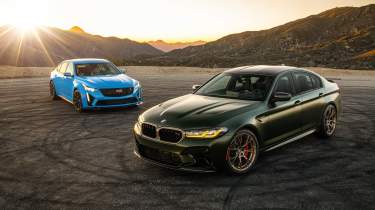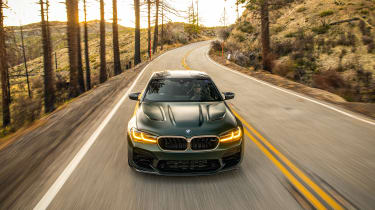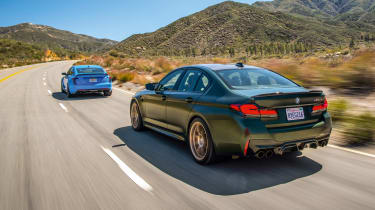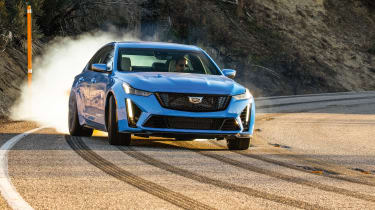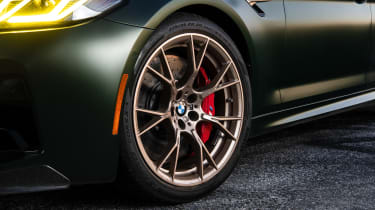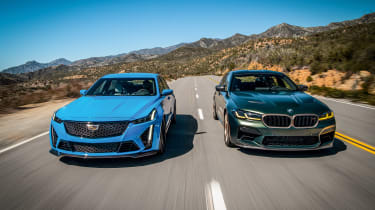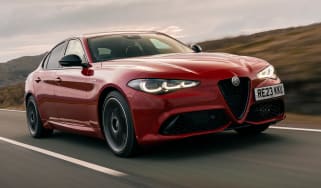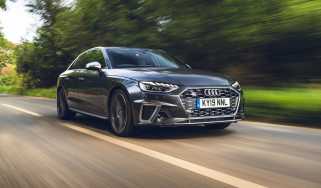Cadillac CT5-V Blackwing v BMW M5 CS
It’s the clash of the supersaloons as Cadillac’s mighty CT5-V Blackwing takes on our reigning Car of the Year, BMW’s sensational M5 CS
Invincible. It’s the only way to describe how the BMW M5 CS felt on last year's evo Car of the Year test. On narrow, bumpy roads, this huge car seemed small and absurdly agile. When the rain came down and others floundered, the CS cut through the water and armed its driver with so much feedback that driving up to its considerable limits was easy and intuitive. Nothing could get close. Surfaces that perplexed the Porsche 992 GT3 and unravelled the Ferrari SF90 were deftly dissected. No four-door saloon had ever emerged a winner at eCoty until 2021. The M5 CS walked it.
Today there’s no chance of rain. And seeing the M5 CS line up against a car built by Cadillac, you’re probably thinking there’s even less chance of the BMW’s invincibility being dented. We’re on the canyon roads of California, home territory for the Caddy, but no matter the stage surely BMW’s greatest ever supersaloon will shrug off the challenge of a car built by Cadillac? Well, maybe. But the CT5-V Blackwing is something very special in its own right and a similar no-stone-unturned project to build the ultimate supersaloon. The headlines don’t convey the full detail but they certainly whet the appetite: 668bhp, 6.2-litre supercharged V8, rear-wheel drive and, get this, a six-speed manual gearbox.
> BMW M5 CS 2022 review – our 2021 evo car of the year
It looks small and angry, seemingly at bursting point: you sense the engine and all the accompanying hardware that 668bhp and 659lb ft requires have been squeezed into place. It sits low on 19-inch wheels, and the unfashionably plump sidewalls poke out beyond the stretched wheelarches. Behind the multi-spoke rims are optional carbon-ceramic brakes with six-piston calipers at the front and four-piston at the rear. What you can’t see are the MagneRide 4.0 dampers featuring new accelerometers and an inertial measurement unit that transmit and process changes in road conditions four times faster than previous set-ups. Around 1000 times per second. They even have secondary temperature maps to ensure consistent performance as the dampers work harder and start to heat up.
Delve deeper and there’s so much more, including an e-diff in a new aluminium housing (with its own cooler) to save 10kg over the old CTS-V. Much work was done on engine airflow (up 46 per cent) and the oiling system. In fact, so determined were Cadillac to ensure the Blackwing’s endurance that they carried out a continuous 12-hour track session on the manual-equipped car and a 24-hour session for the ten-speed automatic. Maybe their arms got tired. Anyway, the Blackwing is billed as ‘track ready’. So what we have here is a saloon that’s dimensionally somewhere between M3 and M5 but packs more power than the 626bhp of the CS, a substantial 106lb ft of extra torque, carries a little more weight at 1870kg and is capable of over 200mph. All for less than $85,000, or around $110,000 with the carbonfibre packages for increased downforce, carbon-ceramic brakes and the cool carbonfibre seats. That’s around £83,000. The M5 CS is $142,995 in the US as standard by way of comparison.
Drop into the slim seats and the Blackwing feels compact. More so than the M5 CS and, surprisingly, more so even than the latest M3. Part of that is because the seat is a shade too high so you feel a little on top of the car. It’s a momentary distraction rather than a fatal flaw. We’re talking degrees here. The small steering wheel, top-marked with a red band, feels great, and it’s just a short reach across to the stubby, short-throw lever for the six-speed ’box. The novelty of finding three pedals and a stick in almost any modern performance car is deeply exciting, even more so when it’s connected to nearly 700bhp and allows ‘no-lift shifts’. What a treat.
Initially it’s all about the 6.2-litre supercharged ‘LT4’ engine, however. It starts with a big, throaty boom and whilst there’s none of the jagged, triumphant theatre of an AMG V8 you just know the noise comes from something large. The LT4 engine is hand-built, features titanium intake valves, ‘Rotocast’ aluminium cylinder heads (the cast is rotated in the mould to make for a denser, less porous and stronger component) and is boosted by a 1.7-litre four-lobe Eaton supercharger. At idle it’s got that lovely, deep and slow ker-dunk-ker-dung-ker-dunk uneven throb that’s pure Americana, albeit without the volume of an old muscle car lining up late on a Saturday night at a stop light.
Inside it’s even more mannered. You feel the beat of the engine like distant thunder – tangibly powerful but not so forceful that it feels intimidating or uncouth. The gearbox is relatively light to use and has a smooth, polished action, and with such abundant torque it’s simple to manoeuvre around without even bothering with the throttle. Yet whilst you can be lazy, the car feels anything but. The Blackwing has a lovely tension in the way it operates. Everything from the responsive steering to the sophisticated ride has a fluid precision to it that beggars belief if you’re not well-versed in the dynamic abilities of Cadillac’s and GM’s best US offerings (the excellent Camaro, for example, which rides on the same Alpha platform, featuring struts up front and a five-link independent rear).
Just as with the M5 CS, there’s endless configurability here via pre-set modes that run from Tour to Sport, Track and Snow/Ice, plus a shortcut V button on the steering wheel that ramps everything up to max. You can also mix and match various settings, and even the brake pedal response and travel is adjustable. Cadillac’s Performance Traction Management further allows you to play with the car’s personality; the most permissive Race 1 and Race 2 modes leave just traction control engaged and at a very tolerant level.
This should make for a confusing, frustrating first few miles, but on these wide, coarsely surfaced but largely smooth roads the Blackwing feels pretty much perfect in Track mode and with the PTM dialled right back to Race 2. Such is the feedback, strong traction and the confidence afforded by supremely powerful brakes, the Blackwing immediately feels on your side. The damping is really well judged with excellent body control but a fantastic ability to deal with broken bits of tarmac. The steering isn’t alive with texture or subtle shifts in weight but there’s accuracy in abundance and the front end is absolutely locked on its line.
In fact, this near-1900kg saloon is stunningly pointy and feels genuinely agile. I’m not sure I’ve ever driven a four-door so keen to turn and yet with the rear stability to live with the way the front tyres snap towards an apex. Start to really hustle and you’ll push that trait to the limit and eventually the rear will just start to get out of phase. But here’s the best bit. It doesn’t give up. The rear axle slips wide but very, very gently, and in so doing keeps those front 275-section Michelins tracking true. A Blackwing on the edge like this is an intensely exciting experience. Adjustable and hungry to deploy all of its power, not with brute force but balance and light-touch control. There’s such finesse on display.
Experience tells me that these roads can flatter. They are glorious and never-ending – a true playground – but very few of the corners tighten or hold a nasty compression or crest to surprise the chassis. Most are quick, third-gear turns too, so the chassis never has to deal with abrupt inputs or a sudden extra load of power. You turn in quickly and then progressively load the chassis, more like a kind of seven-tenths racetrack than the sort of roads we’re used to in the UK or Europe that require greater dexterity and can ask many questions all at once. Luckily, we have the ultimate four-door benchmark shadowing the Blackwing. The M5 CS, painted a wicked shade of Frozen Deep Green Metallic, has been keeping a respectful but constant distance. There’s no dropping this car.
You sink way down low in the M5 CS and then stop abruptly as your backside hits those uncompromising but fantastic seats. The carbonfibre hump between your legs is a little odd but I find them very comfortable and brilliantly supportive. The steering wheel feels huge after the Caddy’s almost Porsche GT3-style diameter rim, but the quality is a couple of notches above in here. It just feels more expensive in every way and more special, too. The lack of a manual shifter somehow fits the focused environment and the carbonfibre paddles have a lovely, almost mechanical action. It’s funny that physically it seems a size above the Blackwing yet the signals you get are uncompromisingly sporting. You just know the M5 CS prizes dynamics above everything else and it imparts a pure sense of purpose to rival a lightweight Porsche or McLaren.
The 4.4-litre twin-turbocharged V8 has less innate drama than the slow, loping percussion of the heavy metal LT4. It starts with a typically fast, deep-lunged burp and then idles rock solid. There’s energy and intent but it feels vaguely synthesised to overcome a naturally subdued tone. With ‘just’ 626bhp and 553lb ft, the BMW should feel substantially outmuscled and the aggressive P Zero Corsa tyres are perhaps there to magic-up agility that wouldn’t otherwise exist. Even though I know and love the CS, the Blackwing’s character and ability to use its sledgehammer power with grace and poise seems a tough act to follow.
Between three and four seconds later I can relax. The CS, no matter the context or competition, is simply outrageously good and is clearly capable of standing toe-to-toe with the Blackwing even with its home advantage. First impressions centre on how the CS manages to feel lithe and supple and yet communicate the road’s surface so clearly. The steering wheel may be big but it’s tingling with messages and, perhaps because you can sit so low in the chassis, the CS seems to dig deeper into the surface when you ask it to change directions. It feels more stable, more within itself. On these roads the dampers can be dialled to full stiff, the steering to Sport and, of course, selecting 4WD Sport provides balance as well as reassurance. The rear-drive mode is a fun party piece but 4WD Sport is the CS at its optimum.
The 4.4-litre twin-turbo V8 is an absolute monster. A flat torque delivery suggests it might feel muscular but rather one-dimensional, but in reality it’s searingly sharp and bristles with precision. The response is linear and predictable but violent in force and creates a kind of sensory overload. It’s just so fast. The eight-speed auto helps. Wonderfully sharp and with relatively short ratios – especially compared with the Cadillac, which does over 80mph in second gear – it ensures the CS is always right in that sweetest, angriest zone. I adore that the Blackwing has a six-speed manual, but rather bizarrely you find yourself interacting more with the M5’s engine and ’box simply because the tightly stacked gearing provides real impetus to do so. On these roads in the Cadillac you pretty much select third and forget about rowing the shifter around. Which sort of defeats the point. Perhaps the ten-speed auto isn’t such a bad idea?
The Cadillac clearly beats the BMW for brake response. Both of these cars have carbon-ceramics but the Blackwing’s pedal is much more immediate and still retains good progression. The steering is a degree or two more responsive and reassuring as you initially tip into corners, too. The CS has its own tricks to counter, though. The steering feel once you’re into a turn delivers a lucid, detailed picture that breeds confidence. So much so that soon you’re really, really leaning on this huge car and giving the four-wheel-drive system every one of those 626bhp with which to deal. You’d think the CS would start to feel all 1825kg and more… but it simply gets better and better. Traction is remarkable, the balance so natural and rear-led that the M5 never runs out of composure and always does exactly what you ask of it. For such a big car it’s truly incredible and properly, heart-thumpingly exciting.
The Blackwing keeps a cool head, too. In terms of balance it’s a very close run thing. The CS has finer body control and traction but the Cadillac, of course, is even more easily adjusted on the throttle. On track it can be a real oversteering beast, as you’d expect, but the road demeanour isn’t wild or unruly and the sophisticated traction control system does a great job of allowing you plenty of free rein to experiment without abandoning you to the mercy of 1870kg and 659lb ft. You’ll rarely overload the front tyres, so the Blackwing feels lovely and acrobatic, nailing each apex with light-footed ease and then slipping into just a few degrees of oversteer as the torque takes hold of the rear wheels. The straights are eaten up with howling intensity just for good measure.
Only when you try to match the CS blow-for-blow does the Blackwing start to occasionally feel stretched. The rear axle will hop and wander under full power on uneven surfaces, there’s a little less stability when you’re really using those fabulous brakes, the traction control system has to get busier and more abrupt. You can lose the assistance altogether, which is not a wild gamble by any means, but without that electronic help you find yourself consciously waiting an extra breath or two so as not to shock the rear wheels with too much power. Just when the CS experience hones in to a fine, seamless point, the Blackwing can feel a little frayed around the edges. These are fine margins, but the M5 CS has a quality and depth of ability that is just beyond the reach of the Cadillac. And that’s on dry, well-sighted and mostly predictable roads. I imagine on the ragged, tumultuous roads of the Scottish borders or Welsh mountains these traits would only be exaggerated.
In short, the BMW M5 CS remains invincible. It’s an extraordinary supersaloon. Perhaps the best there’s ever been. You see, it’s not defined by its shape or size, but by its mission. The CS feels like a beautifully and meticulously detailed sports car that happens to have four doors and a boot. As luck would have it, the very measures taken to make it work with such precision and control – for example the superb damping – happen to make the CS a rather nice saloon car, too. It’s a shade noisier than a normal M5 but considerably more supple, and those extreme-looking seats are comfortable, supportive and so slim that they create more rear legroom for passengers, too. Remember when Renault Sport built the most focused, dazzlingly agile, stripped-out, roll-caged hot hatch they could imagine in the creation of the R26.R and almost by accident created a car that came alive on the most challenging roads? BMW has pulled the same trick with the M5 CS. It’s a stunning achievement.
That the CT5-V Blackwing pushes BMW’s masterpiece so hard and for so little money is deeply impressive, too. I love the way it looks, the sheer stonk of its engine and its remarkable agility. I love its manual gearbox too, even if I wish the ratios encouraged a bit more interaction at sane speeds. Being undone by the M5 CS is no disgrace. It’s the car for all occasions. The GT3-slayer. The ultimate one-car fantasy garage. And any other cliché you might wish to decorate it with. But should you want a few more cars just for the fun of it – and who doesn’t? – the CT5-V Blackwing is well worth your consideration. Howling into the sunset, supercharged V8 at full cry and picking up the Caddy like an old tube-framed hot rod, rear tyres right on the edge of adhesion and gently scorching faint black lines into the surface, you might even forget that the M5 CS exists. For a few minutes.
Cadillac CT5-V Blackwing v BMW M5 CS specs
| Cadillac CT5-V Blackwing | BMW M5 CS | |
| Engine | V8, 6162cc, supercharged | V8, 4295cc, twin-turbo |
| Power | 668bhp @ 6500rpm | 626bhp @ 6000rpm |
| Torque | 659lb ft @ 3600rpm | 553lb ft @ 1800-5950rpm |
| Weight | 1870kg | 1825kg |
| Power-to-weight | 363bhp/ton | 349bhp/ton |
| 0-60mph | 3.6sec | 3.0sec |
| Top speed | 205mph | 189mph (limited) |
| Price | c$110,000 (c£83,000) | £140,780 |
This story was first featured in issue 297.

